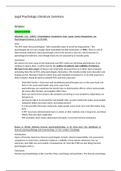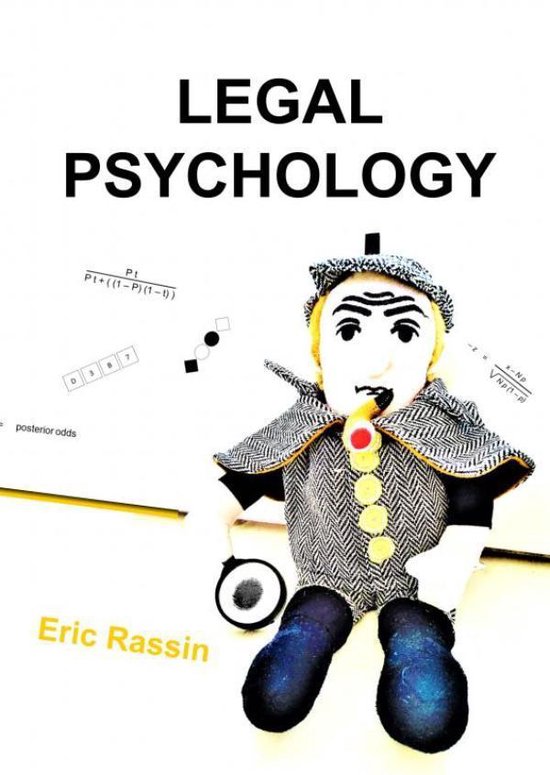Legal Psychology Literature Summary
Articles
Lecture 2 Articles
Lilienfeld, S.O. (2007). Psychological treatments that cause harm. Perspectives on
Psychological Science, 2, 53-70 AND
Intro:
The APA states that psychologists "take reasonable steps to avoid harming patients." But
psychologists do not care enough about potentially harmful treatments, or PHTs. There is a lot of
hate towards medicines, which go through a lot of trial and error, but not a lot of criticism of
psychological treatments, even though these are not assessed by an outside party.
Conclusion:
We need to be more away of fad treatments and PHTs which are still being administered. If we
continue to ignore them, it will be bad for the welfare of patients and credibility of clinicians.
We have to be extra aware of flaws in our treatments because there is no other team of people
evaluating them like an FDA, only psychologists themselves. We should provide more education and
training on this, because it doesn't matter how well-intended a treatment is, it can still cause harm.
More research should be done to identify PHTs and their outcomes.
- Dodo Bird Verdict = that most well-established psychotherapies are on the same level, but
they're not, some work better and some cause harm
- psychotherapy can sometimes be harmful due to deterioration effects, where some people
get worse after therapy, and negative effect sizes
- there are many forms of harm, like symptom worsening or new symptoms, dependency on
therapist etc
- we have to take in to account the cost-benefit ratio, as some treatments make some people/
symptoms better and some worse, increasing variance
- it is also possible that some treatments make people worse short term and then better long
term
- A PHT must have demonstrated harm in clients or their relatives, that is long term, and these
effects have also been replicated.
- PHT examples: boot camps, attachment therapies, recovered-memory techniques
Rassin, E. (2016). Defining forensic psycho(patho)logy. In M. Cima (ed.). The Handbook of
forensic psychopathology and treatment(pp. 15-24). London: Routledge
Introduction:
Topics of forensic reports by forensic psychologists include criminal responsibility, risk assessment,
competence to stand trial, confession evidence, credibility of eye witness testimony, line-up
outcomes, and child care and custody. Consequences of crime like PTSD are also things forensic
psychologists work in.
Conclusion:
Forensic psychopathology is like a combo of law, psychology and psychiatry. The forensic psychology
,field is not that big, but forensic ex-patients commit far less crime than ex-prisoners, so there is
reduced recidivism. An idea to help improve this more, perhaps, is to not look at convicts as
disordered or non-disordered but to provide every prisoner with forensic treatment to prepare for
returning to society.
- recidivism rates after incarceration are high
- theories of behaviourism explain why recidivism is so high, as real life punishment is not as
accurate as laboratory settings
- we don't give disordered patients standard punishment as they are incapable of learning
from it, because their behavioural inhibition system is impaired
- recidivism is high in mentally disordered offenders
- the Dutch system of criminal irresponsibility states that the goal of punishment is retribution
and prevention, if the only goal was incarceration criminal irresponsibility wouldn’t matter
- incarceration has negative effects on mental functioning
- most forensic patients have antisocial personality disorder, psychosis, or paraphilia
- we now don't look much at classic notions like whether a criminal knows right from wrong,
but more on what traits predict recidivism, like psychopathy, which is the best predictor of
future offending
Lecture 3 Articles
Buss, A.H. & Perry, M. (1992). The Aggression Questionnaire. Journal of Personality and Social
Psychology,63, 452-459.
Abstract:
A new questionnaire on aggression was made with 4 scales: physical aggression, verbal aggression,
anger, and hostility. Anger links aggression and hostility. Men are higher on aggression and hostility,
but men and women are the same on anger.
Introduction:
Buss and Durkee made a Hostility Inventory for aggression, which had 7 scales: assault, indirect
aggression, irritability, negativism, resentment, suspicion, and verbal aggression, so we can see how
aggression is expressed. We need a new questionnaire because the seven scales were established a
priori, so factor analysis found some differences. They are also on a true-false item scale, which is
less acceptable for participants than a Likert scale, because your answer has to be all or nothing.
- verbal and physical aggression show behaviour, anger shows emotion, and hostility shows
cognition
- high correlation between physical and verbal aggression
- women inhibit their expression of anger
Eckblad, M. & Chapman, L.J. (1983). Magical ideation as an indicator of schizotypy. Journal of
Consulting and Clinical Psychology, 51, 215-225.
Abstract:
A true-false scale was made for magical ideation = belief in forms of causation that by normal
standards are invalid. People high on magical ideation were interviewed using something for
Affective Disorders and Schizophrenia. People high on magical thoughts had more psychotic
,experiences, schizotypal experiences, affective symptoms, and difficulty concentrating. So, people
high on the Magical Ideation Scale seem to be predisposed for psychosis, and should be followed-up
long term.
Introduction:
People who are schizophrenia-prone show magical ideation = belief of the possibility that events that
can't have causal relations actually do. Most of the ideations tested for things like schizophrenia or
psychosis are about the person's interpretation of their own experiences, so not the possibility of
these things theoretically. A lot of items are common ideas, like mindreading, but it also covers
things like subliminal messages in the behaviour of others, that doesn't have cultural support. This
questionnaire assumes that different types of pre-psychosis precede different disorders.
- genetic link between schizophrenia and schizotypal symptoms, suggesting relevance of schizotypal
symptoms to future psychosis
Hare, R.D. (1980). A research scale for the assessment of psychopathy in criminal populations.
Personality and Individual Differences, 1, 111-119.
Abstract:
A new scale is being developed to assess psychopathy in criminal populations. The article looks a lot
at the reliability of the test and its ability to discriminate between those with high and low
psychopathy, which was found to be high.
This new scale is needed because
- there is not enough theory and research on psychopathy because we need more/better
assessment tools (we don't know well enough if the tools we have correlate with each other)
- we should investigate for a longer time the behaviour of incarcerated people and not just
look at questionnaire results from one day
- assessing psychopathy should be more clinical
Introduction:
Assessing psychopathy from a clinical perspective seems to have good interrater reliability. However,
this is subjective and there's not a specific precise measurement being made. But what is in the DSM
is "too liberal" when it comes to diagnosing, a lot of criminals fit antisocial personality disorder but
much less fit psychopathy, for example. So this article tries to make a more objective method for
identifying criminals.
Discussion:
Even though this is a new scale it seems useful, and looks at psychopathy in a clinical sense, so is a
good alternative for the successful but subjective alternatives. Basically - what was before was either
too subjective or too general/not clinical enough and this one has the best of both.
Jones, D.N. & Paulhus, D.L. (2014). Introducing the Short Dark Triad (SD3): A Brief measure of dark
personality traits. Assessment, 21, 28-41.
Abstract:
Three socially aversive traits: Machiavellianism, narcissism and psychopathy are the Dark Triad. SD3 =
Short Dark Triad is developed in this article, and was found to be a good measure of the Dark Triad.
, Introduction:
It is important that we don't blur the three personality factors and see them as individual traits.
However, sometimes studying all 3 separately requires too much time/effort. We need a short,
reliable measure of the three - so the SD3 was developed.
- Machiavellianism = lack of morality, cynical worldview, coalition forming, reputation
building, planning. Main 3 elements: manipulativeness, callous affect, and strategic-
calculating orientation
- Psychopathy = impulsive, abandon relationships, little attention to reputation, callous affect,
low self-control, lying for short-term rewards even if bad long-term.
- this study emphasized more secondary psychopathy as opposed to primary psychopathy as
to make it more different to Machiavellianism
- Narcissism = manipulation and callousness like the others, grandiose identity, entitlement,
self-attributed leadership, need for ego-reinforcement which can be self-destructive, lying to
themselves
Ego-driven outcomes will be predicted by narcissism, reckless antisocial behaviour by psychopathy,
and strategic orientation by Machiavellianism, and all three are cold and manipulating
Articles Lecture 6
Dodier, O. & Denault, V. (2018). The Griffiths question map: A forensic tool for expert witnesses’
assessments of witnesses and victims’ statements. Journal of Forensic Sciences, 63, 266-274.
Abstract:
Expert witnesses assess reliability of young victims because they have high susceptibility to memory
biases. The GQM, or Griffiths Question Map, helps to do this.
Introduction:
We have to be sure that investigative interview practices aren't influential on children's statements.
Open questions are helpful but they are not often used, unfortunately. Closed questions lead to
shorter and less accurate answers. Suggestive prompts cause miscarriage of justice.
Griffiths Question Map = looks at quantities of different question types and also in depth in to
individual questions, taking context in to account.
Adolescents are generally perceived as less credible than young children when testifying about sexual
assault, as they have higher chance of creating false memories, especially in emotional situations.
Gudjonsson, G.H. (1984). A new scale of interrogative suggestibility. Personality and Individual
Differences, 5, 303-314.
Abstract:
The GSS = Gudjonsson Suggestibility Scale can be used to measure individual susceptibility to
suggestion or to look at general population-level mechanisms of interrogative suggestibility. This
study found 2 types of suggestibility: 1) how much people yield to suggestive questions, and 2) how
much people can be made to shift their replies once pressure is there.
Intro:
Questions in interrogation can be loaded with suggestion and misleading cues, or the instructions
may be suggestive and misleading. Suggesting questions = leading questions, which distort





